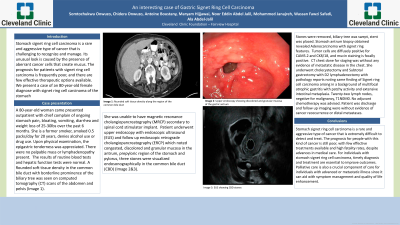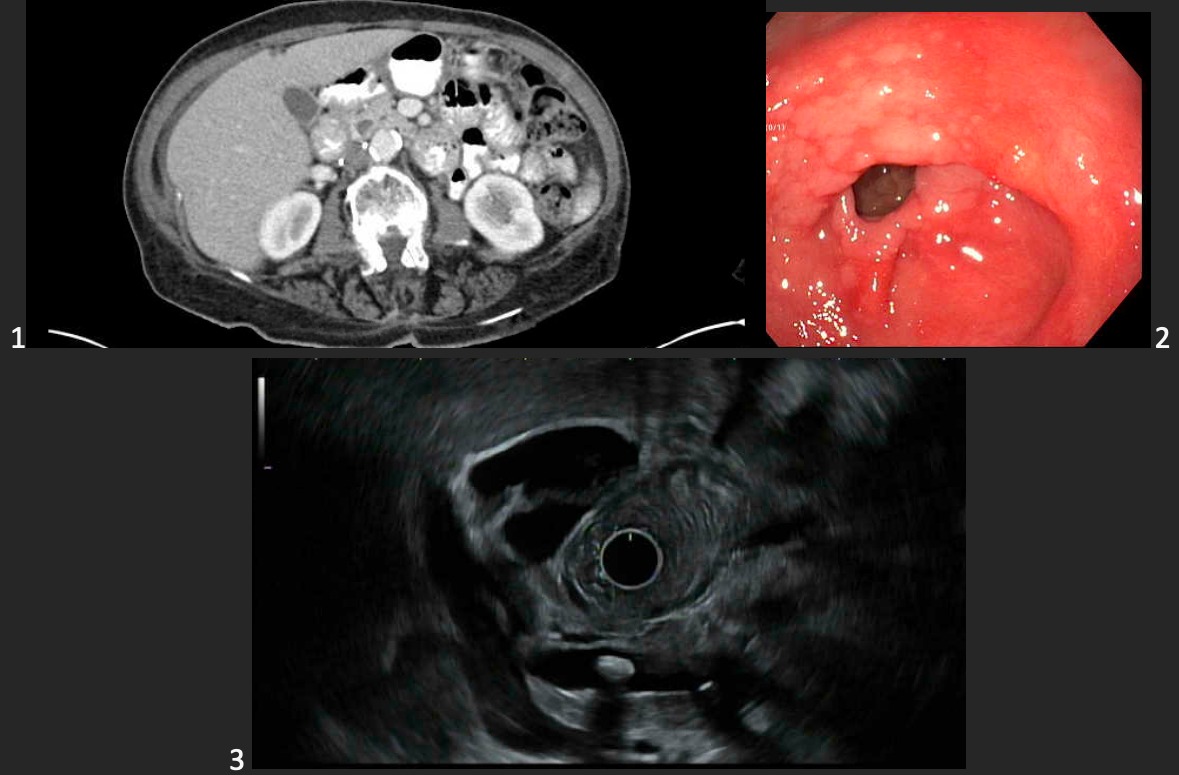Monday Poster Session
Category: Stomach
P2792 - An Interesting Case of Gastric Signet Ring Cell Carcinoma
Monday, October 23, 2023
10:30 AM - 4:15 PM PT
Location: Exhibit Hall

Has Audio

Somtochukwu Onwuzo, MD
Cleveland Clinic Foundation
Fairview Park, Ohio
Presenting Author(s)
Somtochukwu Onwuzo, MD1, Chidera Onwuzo, MBBS2, Antoine Boustany, MD3, Maryam Hijjawai, MD4, Noor Eddin Abdel Jalil, MD4, Mohammed Janajreh, MD5, Wassan Fawzi. Safadi, MD4, Ala Abdel-Jalil, MD3
1Cleveland Clinic Foundation, Fairview Park, OH; 2General Hospital Lagos, Fairview Park, OH; 3Cleveland Clinic Foundation, Cleveland, OH; 4University of Jordan, Cleveland, OH; 5Al-Najah University, Cleveland, OH
Introduction: Gastric signet ring cell carcinoma is a rare and aggressive type of cancer that is challenging to recognize and manage. Its unusual look is caused by the presence of aberrant cancer cells that create mucus. The prognosis for patients with signet ring cell carcinoma is frequently poor, and few effective therapeutic options are available. We present a case of a patient with gastric signet ring cell carcinoma that was found incidentally.
Case Description/Methods: An 80-year-old woman reports vague epigastric discomfort and endorsed a weight loss of 30 pounds over the past 6 months. She was a former smoker for 20 years. On physical examination, there was epigastric tenderness, but no palpable masses or lymphadenopathy. Routine hepatic function tests were normal. A rfounded hyperdensity in the distal common bile duct with prominence of the biliary tree was seen on CT scan consistent with a stone (Image 1). Patient could not have magnetic resonance cholangiopancreatography (MRCP) secondary to a spinal cord stimulator implant. An upper endoscopy noted a congested, discolored, and granular mucosa in the antrum and pre-pyloric region of the stomach. Biopsies revealed adenocarcinoma with signet ring cell features. Tumor cells were diffusely positive for CAM5.2 and CK8/18, and mucin staining was focally positive. CT chest for staging was without any evidence of metastatic disease. Endosonographic exam confirmed a stone in distal CBD (Image 3) but did not show any pathologic lymph node enlargement. Endoscopic retrograde cholangiopancreatography (ERCP) was done and the stone was removed. There was no concerning biliary stricture or findings on ERCP. Patient underwent cholecystectomy and subtotal gastrectomy with D2 lymphadenectomy. Pathology was consistent with signet ring cell carcinoma with a thickness of 7 mm arising in a background of multifocal atrophic gastritis with patchy activity and extensive intestinal metaplasia. Twenty-two lymph nodes were negative for malignancy, with stage T1N0M0. No adjuvant chemotherapy was advised. Patient was discharge and follow-up imaging was without evidence of cancer recurrence or distant metastases
Discussion: Gastric signet ring cell carcinoma is a rare and aggressive type of cancer that is extremely difficult to detect and treat. The prognosis is poor, with few effective treatments and high fatality rate, despite advances in medical care. Careful inspection during endoscopic exam and high-index of suspicion is crucial to detect early developing gastric neoplasia.

Disclosures:
Somtochukwu Onwuzo, MD1, Chidera Onwuzo, MBBS2, Antoine Boustany, MD3, Maryam Hijjawai, MD4, Noor Eddin Abdel Jalil, MD4, Mohammed Janajreh, MD5, Wassan Fawzi. Safadi, MD4, Ala Abdel-Jalil, MD3. P2792 - An Interesting Case of Gastric Signet Ring Cell Carcinoma, ACG 2023 Annual Scientific Meeting Abstracts. Vancouver, BC, Canada: American College of Gastroenterology.
1Cleveland Clinic Foundation, Fairview Park, OH; 2General Hospital Lagos, Fairview Park, OH; 3Cleveland Clinic Foundation, Cleveland, OH; 4University of Jordan, Cleveland, OH; 5Al-Najah University, Cleveland, OH
Introduction: Gastric signet ring cell carcinoma is a rare and aggressive type of cancer that is challenging to recognize and manage. Its unusual look is caused by the presence of aberrant cancer cells that create mucus. The prognosis for patients with signet ring cell carcinoma is frequently poor, and few effective therapeutic options are available. We present a case of a patient with gastric signet ring cell carcinoma that was found incidentally.
Case Description/Methods: An 80-year-old woman reports vague epigastric discomfort and endorsed a weight loss of 30 pounds over the past 6 months. She was a former smoker for 20 years. On physical examination, there was epigastric tenderness, but no palpable masses or lymphadenopathy. Routine hepatic function tests were normal. A rfounded hyperdensity in the distal common bile duct with prominence of the biliary tree was seen on CT scan consistent with a stone (Image 1). Patient could not have magnetic resonance cholangiopancreatography (MRCP) secondary to a spinal cord stimulator implant. An upper endoscopy noted a congested, discolored, and granular mucosa in the antrum and pre-pyloric region of the stomach. Biopsies revealed adenocarcinoma with signet ring cell features. Tumor cells were diffusely positive for CAM5.2 and CK8/18, and mucin staining was focally positive. CT chest for staging was without any evidence of metastatic disease. Endosonographic exam confirmed a stone in distal CBD (Image 3) but did not show any pathologic lymph node enlargement. Endoscopic retrograde cholangiopancreatography (ERCP) was done and the stone was removed. There was no concerning biliary stricture or findings on ERCP. Patient underwent cholecystectomy and subtotal gastrectomy with D2 lymphadenectomy. Pathology was consistent with signet ring cell carcinoma with a thickness of 7 mm arising in a background of multifocal atrophic gastritis with patchy activity and extensive intestinal metaplasia. Twenty-two lymph nodes were negative for malignancy, with stage T1N0M0. No adjuvant chemotherapy was advised. Patient was discharge and follow-up imaging was without evidence of cancer recurrence or distant metastases
Discussion: Gastric signet ring cell carcinoma is a rare and aggressive type of cancer that is extremely difficult to detect and treat. The prognosis is poor, with few effective treatments and high fatality rate, despite advances in medical care. Careful inspection during endoscopic exam and high-index of suspicion is crucial to detect early developing gastric neoplasia.

Figure: CT,EGD/EUS showing mass around the common bile duct & discolored granular mucosa of gastric antrum
Disclosures:
Somtochukwu Onwuzo indicated no relevant financial relationships.
Chidera Onwuzo indicated no relevant financial relationships.
Antoine Boustany indicated no relevant financial relationships.
Maryam Hijjawai indicated no relevant financial relationships.
Noor Eddin Abdel Jalil indicated no relevant financial relationships.
Mohammed Janajreh indicated no relevant financial relationships.
Wassan Safadi indicated no relevant financial relationships.
Ala Abdel-Jalil indicated no relevant financial relationships.
Somtochukwu Onwuzo, MD1, Chidera Onwuzo, MBBS2, Antoine Boustany, MD3, Maryam Hijjawai, MD4, Noor Eddin Abdel Jalil, MD4, Mohammed Janajreh, MD5, Wassan Fawzi. Safadi, MD4, Ala Abdel-Jalil, MD3. P2792 - An Interesting Case of Gastric Signet Ring Cell Carcinoma, ACG 2023 Annual Scientific Meeting Abstracts. Vancouver, BC, Canada: American College of Gastroenterology.
